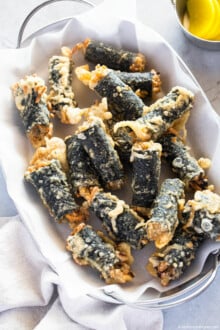If you’ve always wanted to know how to make triangle kimbap, then you’ll want to read this. It’s surprisingly simple to make, and there are many varieties that you can try out. Do you want to know how you can make it? Find out right here!
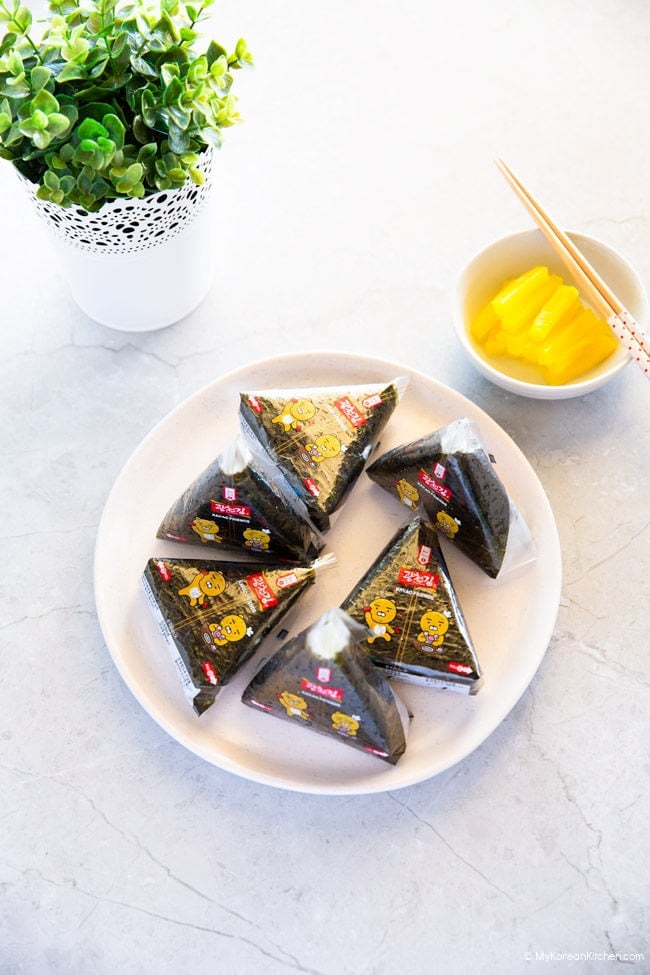
What is Triangle Kimbap (Samgak Kimbap)
Triangle kimbap (samgak kimbap, 삼각김밥) is a Korean dish that is made with rice, vegetables, and meat fillings in thin sheets of dried seaweed.
This sounds a lot like regular kimbap (gimbap), Korean rice rolls, but the difference is that the meat and vegetables are stuffed inside the rice ball before it’s shaped into a triangle. Once you have your rice triangle, it is wrapped in dried seaweed.
Samgak kimbap was first introduced from Japan in the 1990s. Some people describe it as Korean onigiri (오니기리), owing to its similarity to the dish; Onigiri is a general term for Japanese rice balls.
However, in Korea, samgak kimbap typically refers to the triangle rice ball fully wrapped with dried seaweed. If it isn’t wrapped up like this, it’s referred to as jumeokbap, which means Korean rice balls.
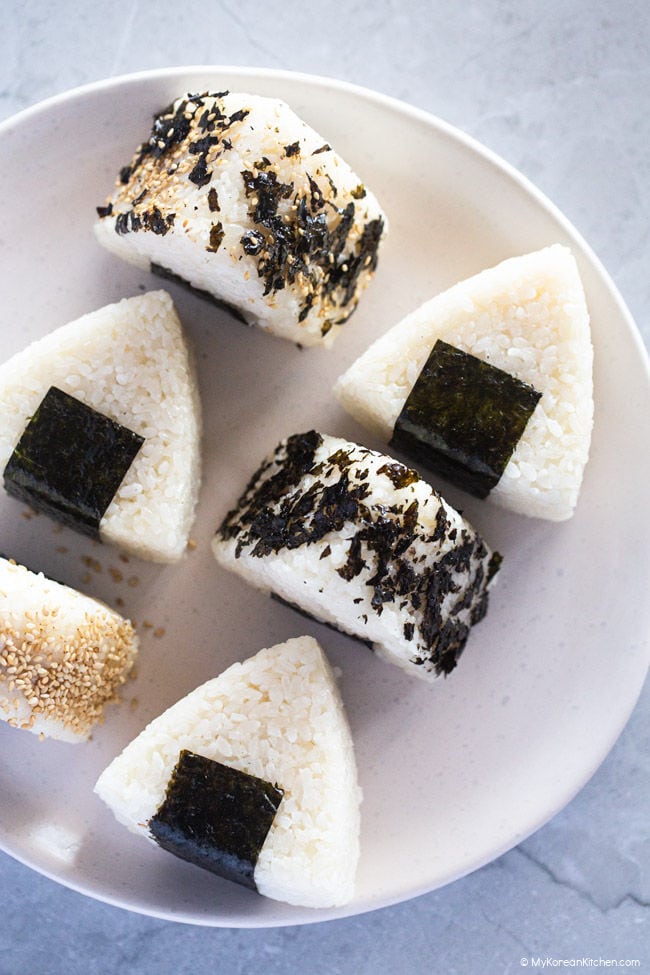
When samgak kimbap was first introduced, it was not as popular due to its relatively high price at the time, and the fillings inside did not suit Koreans’ taste. However, with time and R&D efforts, this changed, and it became popular in the early 2000s, and has been a steady seller since then.
Korean triangle kimbap is typically eaten as a light meal that can be bought from the convenience store. You can eat it straight from the fridge as is, or microwave it if you want something warm. People often accompany it with instant cup noodles to add volume and give soup to go with kimbap.
You can find a range of different fillings inside this triangle kimbap, from bulgogi, to bibimbap to omurice and tuna mayo, for example. These choices give these snacks a more distinctive taste that’ll keep you coming back for more.
How to Make Triangle Kimbap and My Best Tips
Making triangle kimbap is easy once you get used to it and develop a rhythm. Until then, it can be a bit tricky. In this post, I lay out all the things you should know to make triangle kimbap successfully. So I hope you do take time to read through this.
To start off with, you will need these tools to make triangle kimbap.
- Triangle kimbap mold or Triangle kimbap kit, which includes the seaweed wrap and the mold
- Jar spatula, wrapped with cling wrap
Triangle Kimbap Mold
You might be wondering if you need a triangle kimbap mold for this recipe to work?
Making kimbap without a triangle mold can take up extra time and make it difficult to get the same, consistent results. This mold saves your time while also guaranteeing consistent results.
You can easily buy one from a Korean or Japanese grocery store, or you can order from Amazon or eBay.
The size of kimbap molds varies, and you can make your triangle kimbap in different sizes and thicknesses with them. If you’re using pre-packaged dried seaweed in a plastic film (all convenience store’s samgak kimbap have these around them), make sure the seaweed wraps around the triangle rice and folds properly. If you put too much rice or too little rice into the mold, you won’t be able to wrap it well.
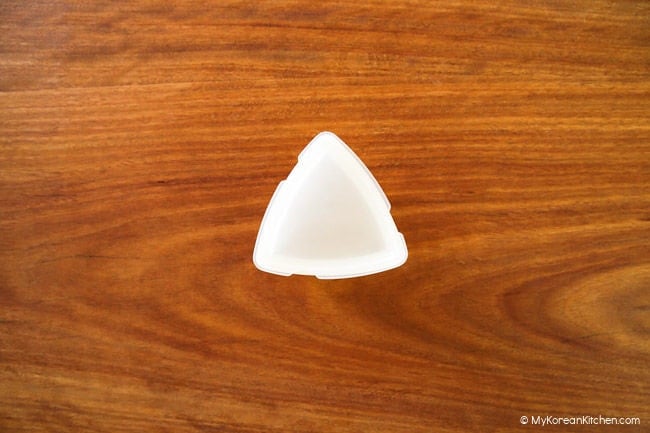
Jar Spatula
You will use a jar spatula to press down the rice. Normally, when using a kimbap mold, you will use the lid to press down the rice. However, if your kimbap mold is quite big, you should fill the rice only to a certain point then use a jar spatula to press down the rice. – As the rice won’t reach where the lid sits.

How to Make Triangle Kimbap without Mold
It is possible to make triangle kimbap without a mold, but it is much trickier as the output will be uneven, and matching the seaweed wrap would be incredibly challenging and time-consuming. Also, the rice will fall apart easier as it won’t be as hard pressed down.
If you still want to make triangle kimbap without the use of a mold, here are some tips on how to do so.
For one samgak kimbap serving, place half a serving of rice onto your palm. Flatten the rice to allow room for fillings. Cover the filling with the remaining half serving of rice and shape into a ball. Shape the rice balls into triangular shape.
Some people use cling wrap to do the above process instead of doing it on their palm, but I found the steps no easier. However, it’s up to you how you would go about it.
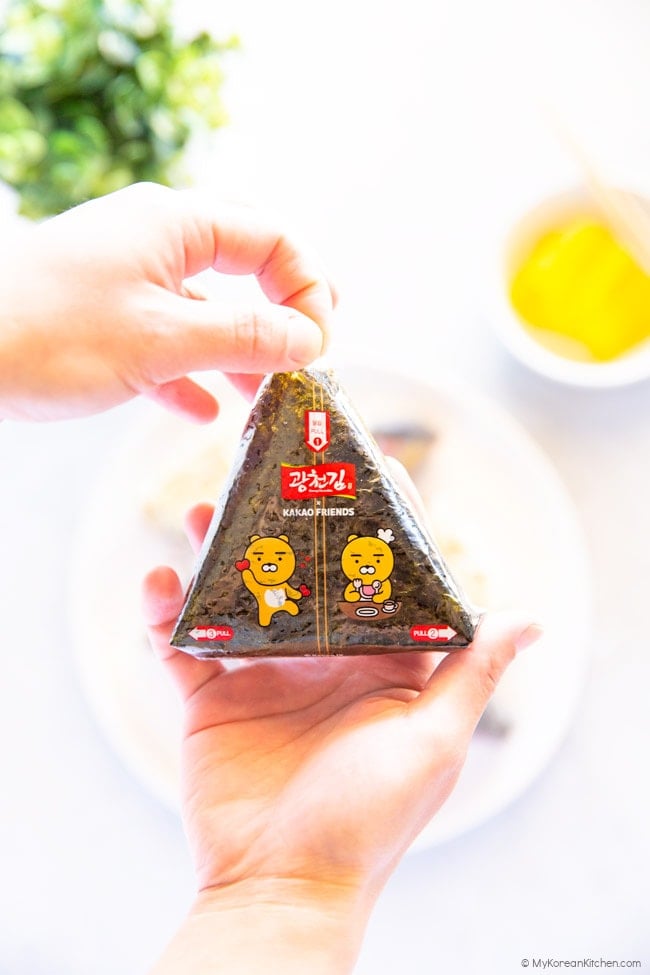
How to Fold Triangle Kimbap
The samgak kimbap seaweed package comes with a dried seaweed sheet covered with plastic wrap. Do not remove the plastic wrap as it will help to wrap the rice easily and keep both seaweed and the rice fresh.
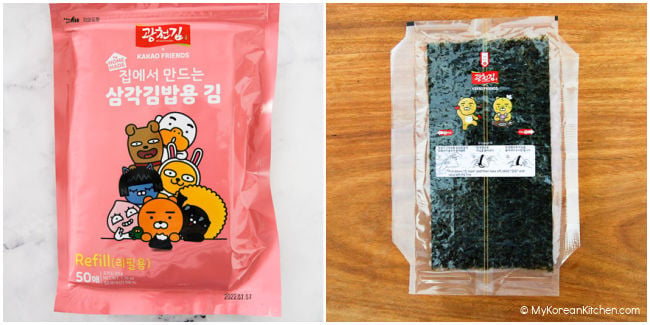
1. Take out the seaweed sheet (film wrap) for samgak kimbap from the package. The plastic wrap has the number side (from #1 to #3) and the blank side. Place the number side face down with #1 sitting at the top.
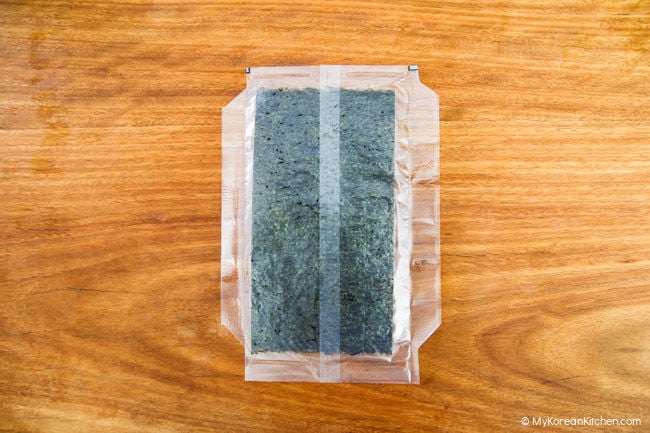
2. Place the triangle rice on top of the seaweed sheet. The tip of the triangle should touch the top layer of the seaweed sheet, towards 1.
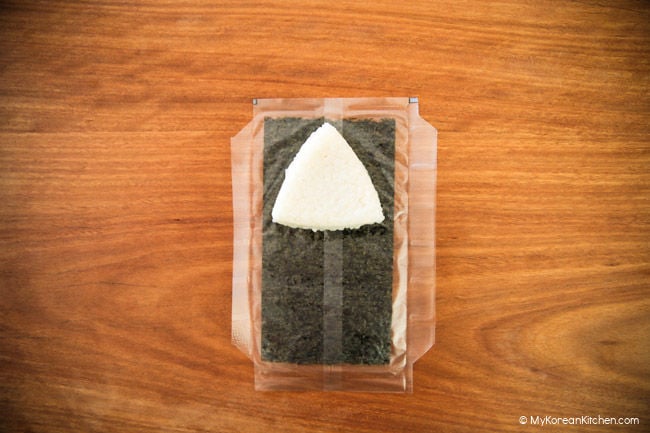
3. Fold the bottom of the seaweed sheet up toward the top and cover the rice.
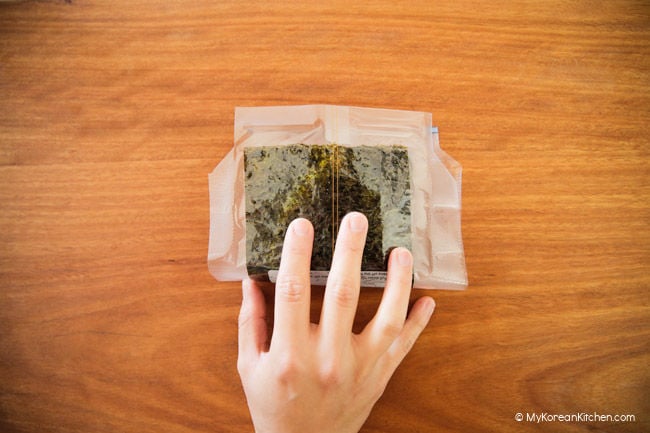
4. Fold down the corner of the seaweed sheet from the left side and tuck it in under the rice. Repeat this for the right side. Fold the seaweed tightly around the rice to maintain the triangle shape.
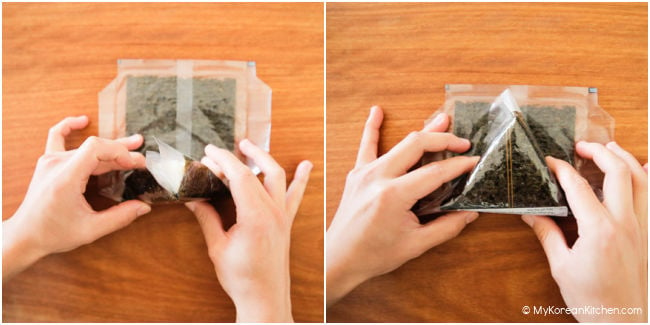
5. Fold down the sides from top left and top right. While holding down the film wrap, place the paper sticker over the adjoining area.
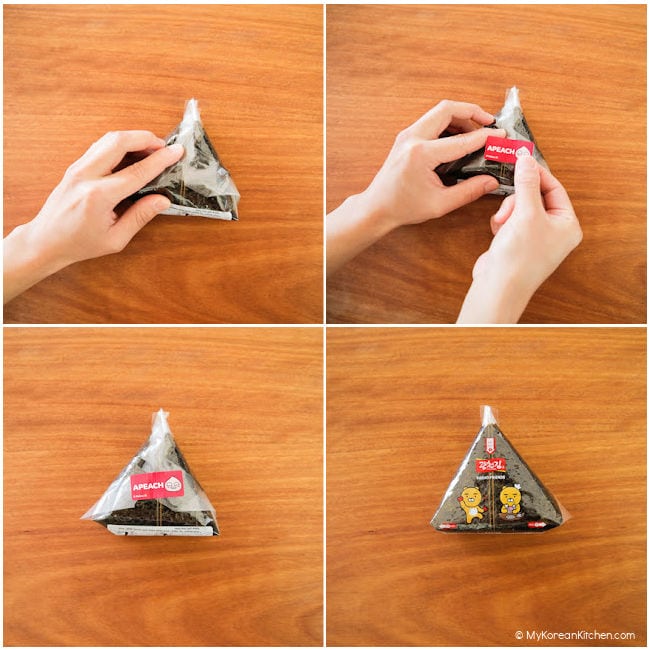
How to Store and Reheat Triangle Kimbap
You might be wondering how well these triangle kimbap will store and if they can be made ahead of time.
My short answer is yes, it stores quite well in the refrigerator and you can make it ahead of time.
Unlike regular Korean kimbap, these plastic-wrapped triangle kimbap can be stored in the refrigerator for 2 to 3 days. I would still place them in an airtight container to give extra protection from drying out, even though they are already wrapped. – No harm in being extra careful!
These kimbap can also be frozen for up to one month. To ensure they stay fresh, I would recommend wrapping them in cling wrap, placing them in a zip lock bag, and sealing it.
To reheat, you can microwave 10-30 seconds for refrigerated triangle kimbap or 45-60 seconds for frozen triangle kimbap. The time will vary depending on your microwave.
One thing I did notice is that refrigerated kimbap tasted fresher than frozen ones. As in the dried seaweed still tastes crisp after reheating, but frozen ones’ got slightly soggy, which could be because it needed a longer reheat time.
All this said, if you’re making triangle kimbap without the film wrap, more like regular Japanese onigiri style, then it is best to consume it on the day of making it because the rice can get dry easier.
It can still be refrigerated for 2 to 3 days. It just doesn’t taste as nice as film-wrapped triangle kimbap. Also, it might fall apart easier particularly after reheating. – Yes, the dried seaweed (with plastic wrap) really does add extra protection! You can reheat these ones in a microwave or on the stove.
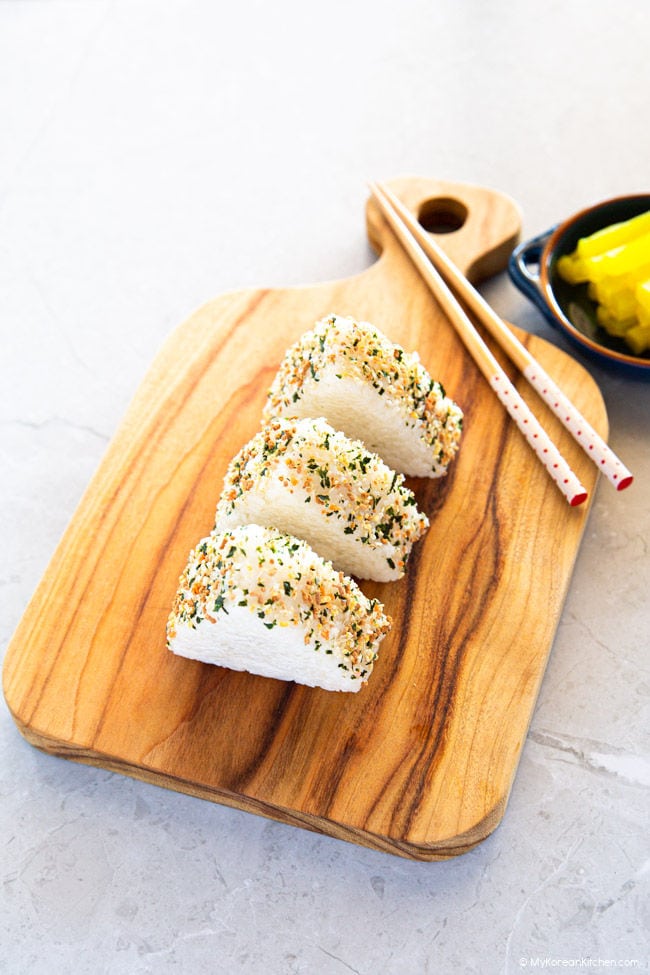
How to Open Triangle Kimbap
Unwrapping a plastic film from triangle kimbap might not seem like it should require much thought, but you could easily tear the seaweed by opening it in the wrong order. So let’s think this through together so you can have an even better experience in eating this dish.
1. Pull down the tab in the centre, where it reads “number 1” and peel. It reaches all the way to the back of the triangle, where you should tear the paper sticker at the back of the kimbap.
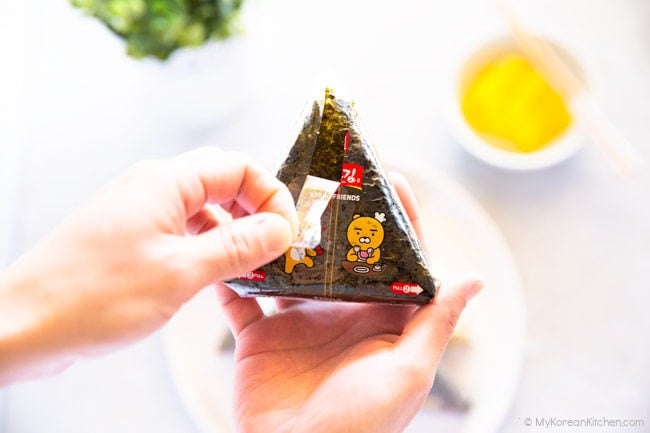
2. While holding down the left side of the kimbap, pull the plastic wrap, where it reads ‘number 2’ (right side). Make sure you don’t accidentally pull out the seaweed, as it will tear. Put the seaweed back into place.
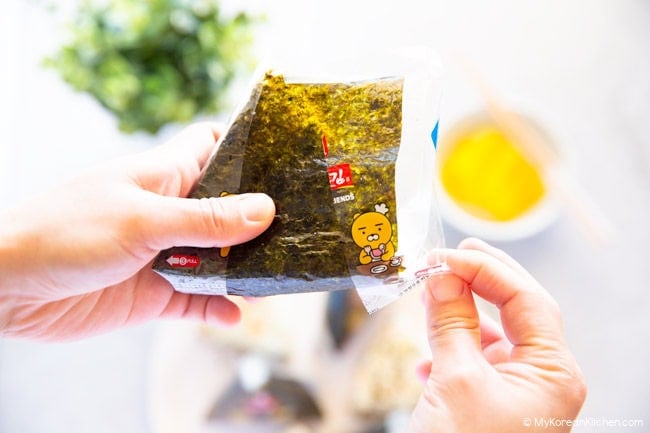
3. While holding down the right side of the kimbap, pull the plastic wrap, where it reads ‘number 3’ (left hand side). Make sure you don’t accidentally pull out the seaweed, as it will tear. Put the seaweed back in place.
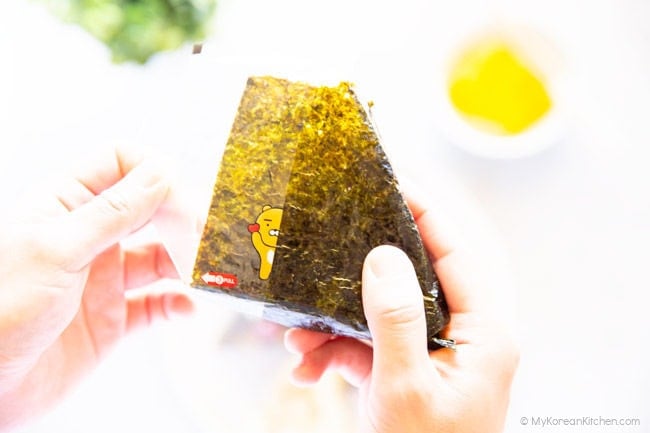
4. Ready to eat now. Enjoy!
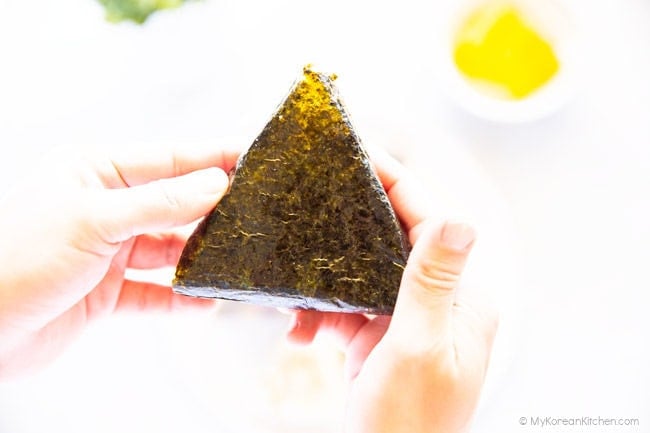
Other Korean Rice Recipes You Might Like
Rice is a staple ingredient in Korean cuisine. Do you want to know how else you can make Korean rice even more delicious? Explore the recipes below.
- Korean Rice Balls (Jumeokbap)
- Yubuchobap (Bean Curd Sushi)
- Tuna Kimbap (Korean Rice Rolls with Tuna)
- Bibimbap (Korean Mixed Rice)
Ingredients for Triangle Kimbap
Tuna Mayo Version (Make 10 Triangle Kimbap)
- 6 cups (995 g / 35.1 ounce) cooked rice, short or medium grain sushi rice (e.g. Koshihikari or Calrose)
- 3 Tbsp sesame oil
- 1/2 tsp fine salt
- 185 g / 6.5 ounces canned tuna, drained
- 3 Tbsp mayonnaise
-
10 dried seaweed sheets for samgak kimbap
Pork Kimchi Version (Make 10 Triangle Kimbap)
- 6 cups (995 g / 35.1 ounce) cooked rice, short or medium grain sushi rice (e.g. Koshihikari or Calrose)
- 3 Tbsp sesame oil
- 1/2 tsp fine salt
- 95 g / 3.4 ounce aged kimchi, cut into small pieces
- 150 g / 5.3 ounce minced pork
- A few sprinkles of black pepper
- 1 Tbsp gochujang (Korean chili paste)
- 1 Tbsp soy sauce, regular (I use kikkoman brand)
- 1 Tbsp honey
- 1/2 Tbsp gochugaru (Korean chili flakes)
- 1/2 Tbsp rice wine (mirin)
- 1/2 tsp sesame oil
-
10 dried seaweed sheets for samgak kimbap
Optional – When Not Using Dried Seaweed Plastic Wrap
- Dried seaweed sheets cut into 3 cm x 9 cm (1.2 inch x 3.6 inch), to wrap around the bottom of the triangle rice balls to serve like Japanese onigiri
- Rice seasoning – Korean or Japanese furikake, to garnish the rice balls and serve like Japanese onigiri
* 1 Tbsp = 15 ml, 1 cup = 250 ml
** If you want to learn more about Korean ingredients, check my essential Korean ingredients list.
How To Make Tuna Mayo Triangle Kimbap
1. In a large bowl, mix the rice with sesame oil and salt. Set it aside until it cools down.
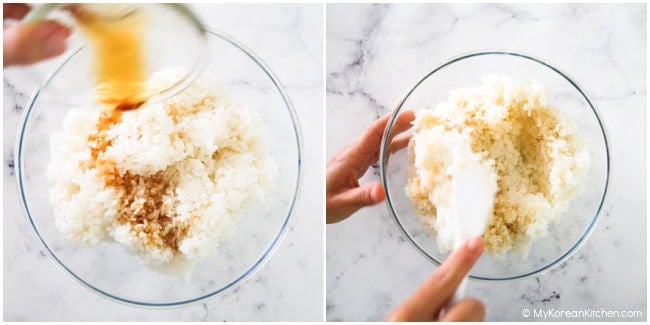
2. Prepare a medium sized bowl and add the drained tuna. Add the mayonnaise and mix them well. Set aside.
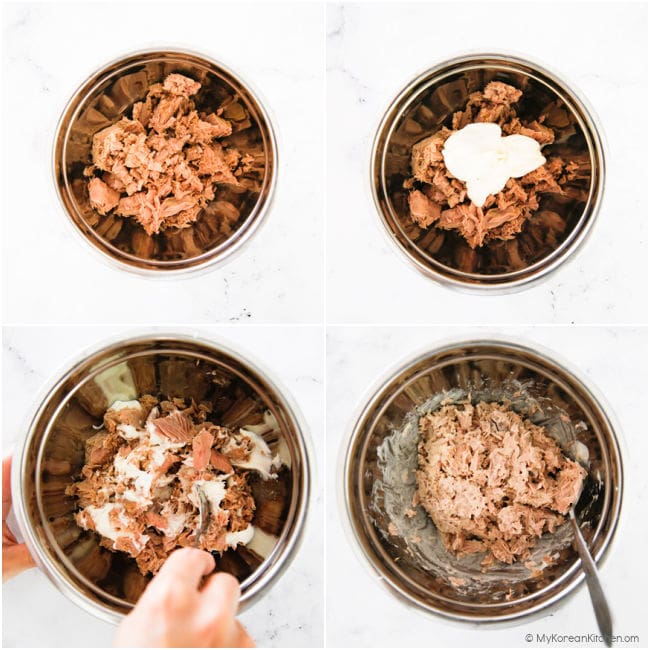
3. Prepare a samgak kimbap mold and fill one third of the mold with the seasoned rice (from step 1). Press down the rice with a small spatula to make the rice stick together better. Make a small shallow space in the middle of the kimbap mold to fill with the tuna mayo filling by pushing the rice slightly to the sides of the mold.
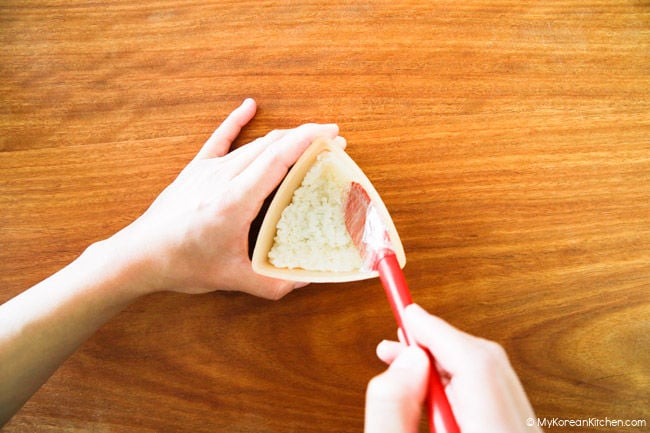
4. Fill the shallow space with tuna mayo and top up with the rice, to about two thirds of the mold. Press down the rice again with the spatula to make the rice stick together. Remove the rice from the mold and set aside on a cling-wrap-covered plate.
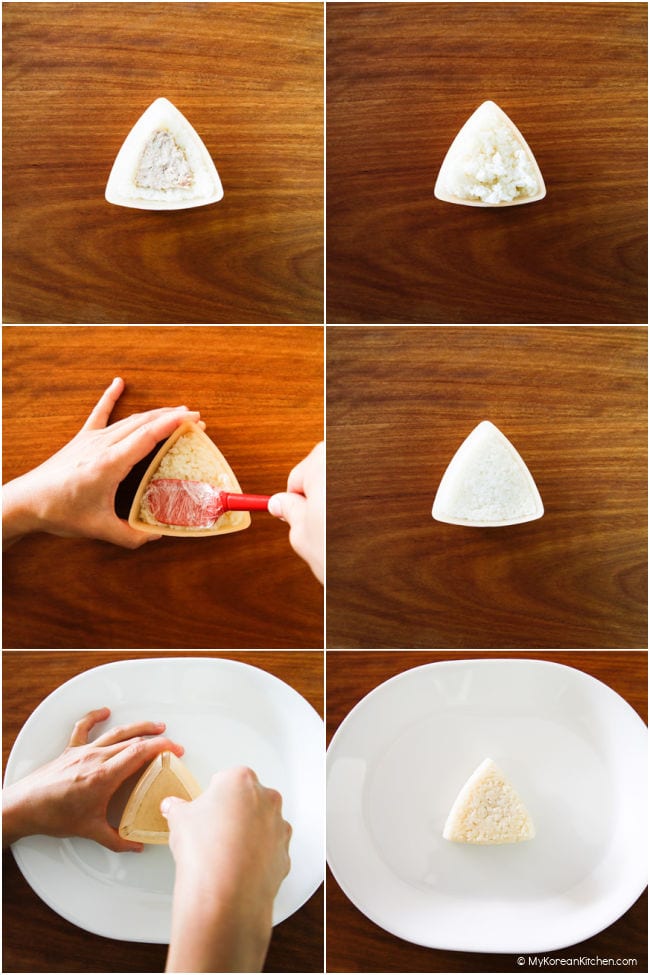
5. Repeat steps 3 to 4 until all ingredients are used up.
6. (1) Wrap the triangle rice with the seaweed plastic wrap following the package instructions. Alternatively, you can follow my step-by-step guide above.
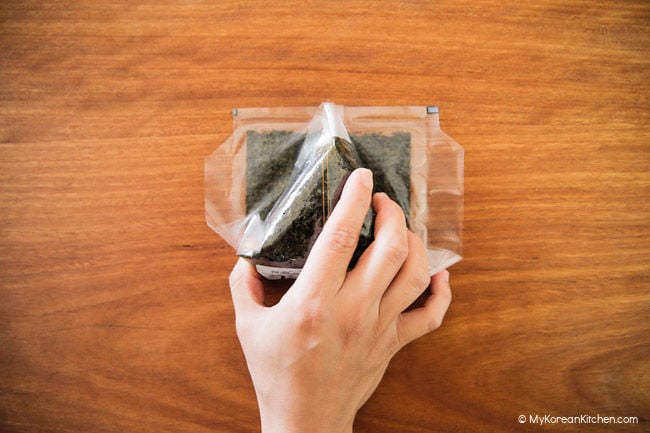
(2) If you don’t wrap with the seaweed wrap for whatever reason, you can use optional ingredients listed above (using regular dried seaweed sheets and/or rice seasoning) to give more flavor and texture to your kimbap. If serving with rice seasoning, dish out a small portion of the seasoning onto a small bowl, dip the sides or the face of triangle kimbap around the bowl to coat it with seasoning flakes.
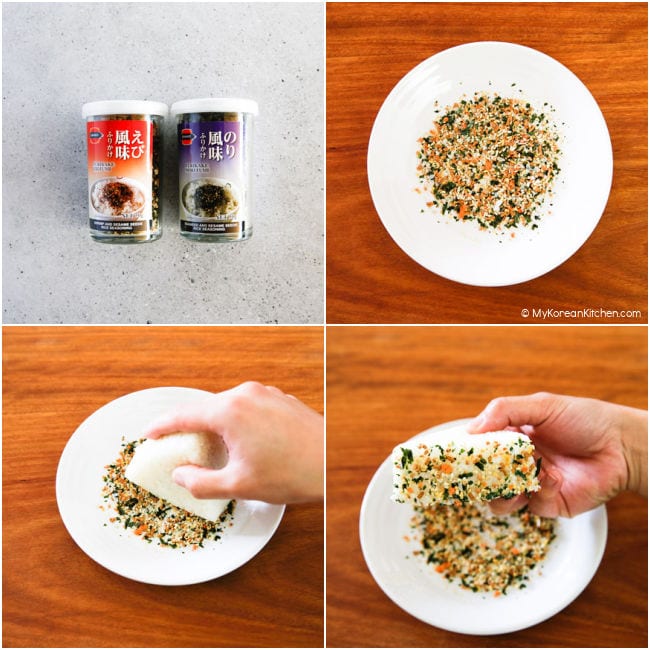
7. Serve.
How To Make Pork Kimchi Triangle Kimbap
1. In a small bowl, make the pork seasoning sauce by mixing gochujang (Korean chili paste), soy sauce, honey, Korean chili flakes, rice wine, and sesame oil.
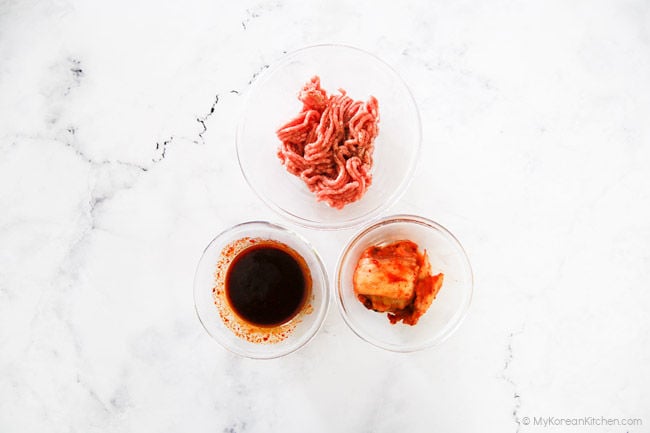
2. Prepare a medium sized bowl. Add the pork, a few sprinkles of pepper and the pork seasoning sauce. Mix them well. Marinate for 10 mins.
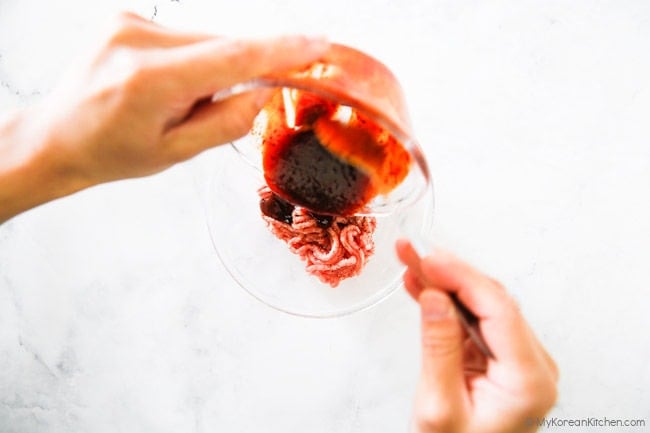
3. In a large bowl, mix the rice with sesame oil and salt. Set it aside until it cools down (about 5 mins).
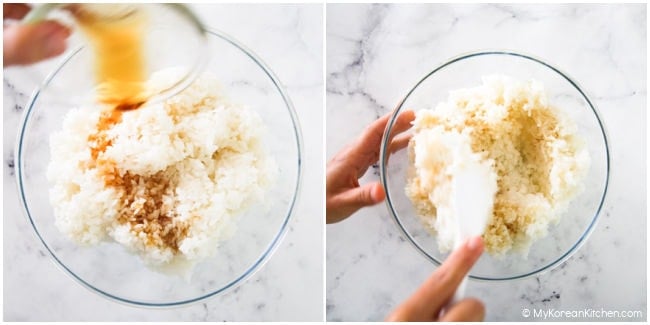
4. In a heated pan, add a small dash of cooking oil and cook the kimchi over medium heat for about 2 to 3 mins. Add the marinated pork and cook until it’s fully cooked. Stir often to break down the meat clumps. Transfer to a clean bowl.
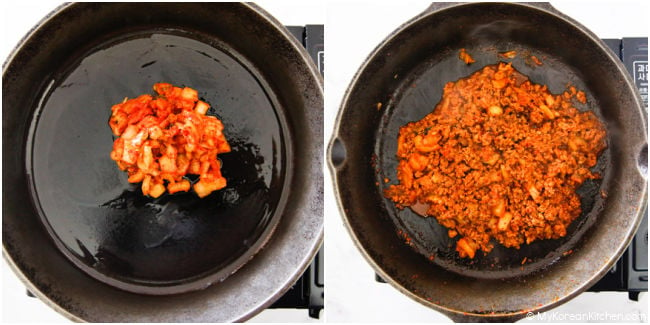
5. Prepare a samgak kimbap mold and fill one third of the mold with the seasoned rice (from step 3). Press down the rice with a small spatula to make the rice stick together better. Make a small shallow space in the middle of the kimbap mold to fill with the pork kimchi filling by pushing the rice to the sides of the mold.
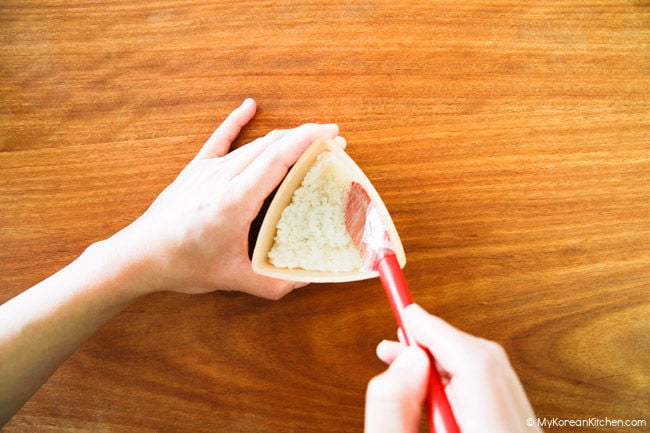
6. Fill the shallow space with stir fried pork and kimchi and top up with the rice, to about two thirds of the mold. Press down the rice again with the spatula to make the rice stick together. Remove the rice from the mold and set aside on a cling-wrap-covered plate. Repeat step 4 and 5 until all ingredients are used up.
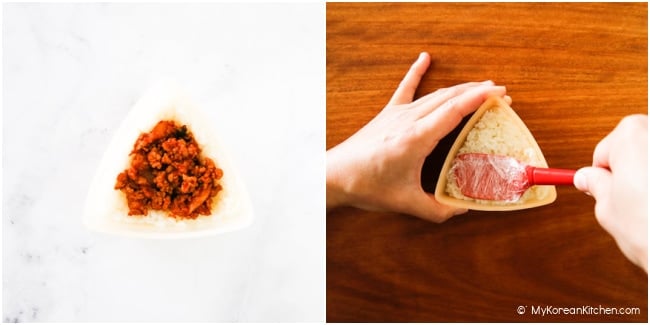
7. (1) Wrap the triangle rice with the seaweed plastic wrap following the package instructions. Alternatively, you can follow my step-by-step guide above.
(2) If you don’t wrap with the seaweed wrap for whatever reason, you can use optional ingredients listed above (using regular dried seaweed sheets and/or rice seasoning) to give more flavor and texture to your kimbap. If serving with rice seasoning, dish out a small portion of the seasoning onto a small bowl, dip the sides or the face of triangle kimbap around the bowl to coat it with seasoning flakes.
Bear in mind, however, that pork kimchi triangle kimchi does show some redness on rice, so it would be more eye-pleasing if you can cover it up with the seaweed.

8. Serve.
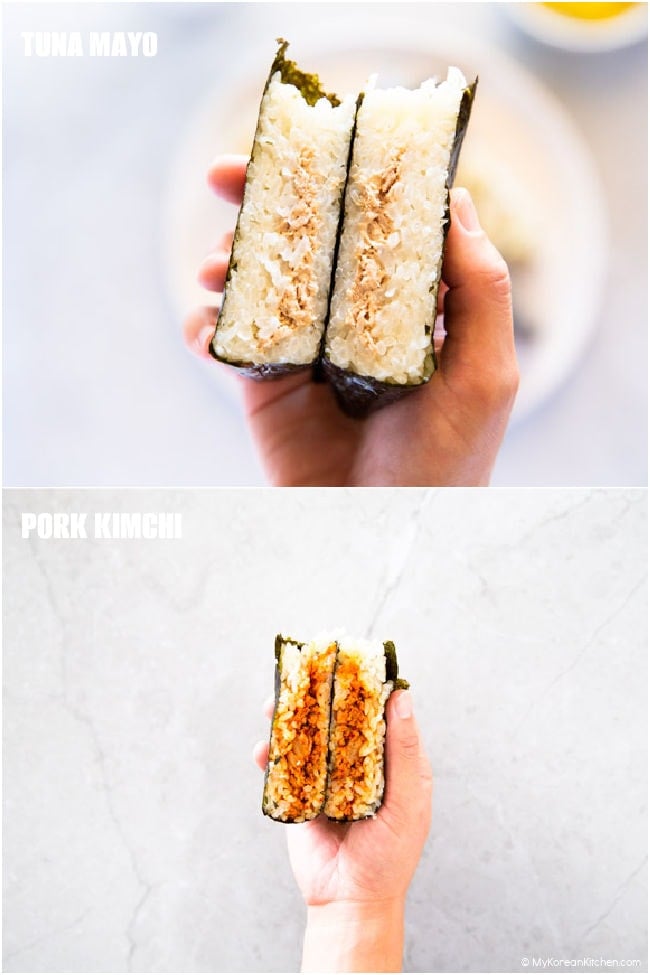
Notes
The reason I’m filling only 1/3 of the mold is to make the kimbap smaller, to make it wrap-able. If your kimbap mold is small and would fit in your samgak kimbap seaweed well, then you can fill the rice up to the half mark. Then, fill the rice fully to the top of the mold after adding the filling.
If you’re unsure of the size of kimbap, it is a good idea to test the first batch of your rice triangle. Wrap the triangle rice with the seaweed wrap and see if it folds well. If it does, then continue. If it is too big or small, adjust your rice triangle size, so that it fits into your seaweed wrap.
Love Korean food? Browse lots more Korean recipes from my easy Korean recipe collections. And subscribe to my newsletter for all of the latest updates including new recipes, what MKK communities are cooking and K-Dramas!
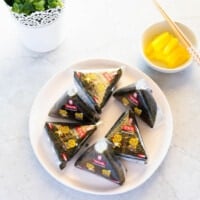
Triangle Kimbap (Samgak Kimbap)
Ingredients
TUNA MAYO VERSION (MAKE 10 TRIANGLE KIMBAP)
- 6 cups cooked rice (995 g / 35.1 ounce), short or medium grain sushi rice (e.g. Koshihikari or Calrose)
- 3 Tbsp sesame oil
- 1/2 tsp fine salt
- 185 g canned tuna (6.5 ounces), drained
- 3 Tbsp mayonnaise
- 10 sheets dried seaweed for samgak kimbap
PORK KIMCHI VERSION (MAKE 10 TRIANGLE KIMBAP)
- 6 cups cooked rice (995 g / 35.1 ounce), short or medium grain sushi rice (e.g. Koshihikari or Calrose)
- 3 Tbsp sesame oil
- 1/2 tsp fine salt
- 95 g kimchi (3.4 ounce), (aged), cut into small pieces
- 150 g minced pork (5.3 ounce)
- A few sprinkles black pepper
- 1 Tbsp gochujang (Korean chili paste)
- 1 Tbsp soy sauce , regular (I use kikkoman brand)
- 1 Tbsp honey
- 1/2 Tbsp gochugaru (Korean chili flakes)
- 1/2 Tbsp rice wine (mirin)
- 1/2 tsp sesame oil
- 10 sheets dried seaweed for samgak kimbap
OPTIONAL – WHEN NOT USING DRIED SEAWEED PLASTIC WRAP
- Dried seaweed sheets cut into 3 cm x 9 cm (1.2 inch x 3.6 inch), to wrap around the bottom of the triangle rice balls to serve like Japanese onigiri
- Rice seasoning – Korean or Japanese furikake, to garnish the rice balls and serve like Japanese onigiri
Equipment
Instructions
HOW TO MAKE TUNA MAYO TRIANGLE KIMBAP
- In a large bowl, mix the rice with sesame oil and salt. Set it aside until it cools down.
- Prepare a medium sized bowl and add the drained tuna. Add the mayonnaise and mix them well. Set aside.
- Prepare a samgak kimbap mold and fill one third of the mold with the seasoned rice (from step 1). Press down the rice with a small spatula to make the rice stick together better. Make a small shallow space in the middle of the kimbap mold to fill with the tuna mayo filling by pushing the rice slightly to the sides of the mold.
- Fill the shallow space with tuna mayo and top up with the rice, to about two thirds of the mold. Press down the rice again with the spatula to make the rice stick together. Remove the rice from the mold and set aside on a cling-wrap-covered plate.
- Repeat steps 3 to 4 until all ingredients are used up.
- (1) Wrap the triangle rice with the seaweed plastic wrap following the package instructions. Alternatively, you can follow my step-by-step guide above.(2) If you don’t wrap with the seaweed wrap for whatever reason, you can use optional ingredients listed above (using regular dried seaweed sheets and/or rice seasoning) to give more flavor and texture to your kimbap. If serving with rice seasoning, dish out a small portion of the seasoning onto a small bowl, dip the sides or the face of triangle kimbap around the bowl to coat it with seasoning flakes.
- Serve.
HOW TO MAKE PORK KIMCHI TRIANGLE KIMBAP
- In a small bowl, make the pork seasoning sauce by mixing gochujang (Korean chili paste), soy sauce, honey, Korean chili flakes, rice wine, and sesame oil.
- Prepare a medium sized bowl. Add the pork, a few sprinkles of pepper and the pork seasoning sauce. Mix them well. Marinate for 10 mins.
- In a large bowl, mix the rice with sesame oil and salt. Set it aside until it cools down (about 5 mins).
- In a heated pan, add a small dash of cooking oil and cook the kimchi over medium heat for about 2 to 3 mins. Add the marinated pork and cook until it’s fully cooked. Stir often to break down the meat clumps. Transfer to a clean bowl.
- Prepare a samgak kimbap mold and fill one third of the mold with the seasoned rice (from step 3). Press down the rice with a small spatula to make the rice stick together better. Make a small shallow space in the middle of the kimbap mold to fill with the pork kimchi filling by pushing the rice to the sides of the mold.
- Fill the shallow space with stir fried pork and kimchi and top up with the rice, to about two thirds of the mold. Press down the rice again with the spatula to make the rice stick together. Remove the rice from the mold and set aside on a cling-wrap-covered plate. Repeat step 4 and 5 until all ingredients are used up.
- (1) Wrap the triangle rice with the seaweed plastic wrap following the package instructions. Alternatively, you can follow my step-by-step guide above.(2) If you don’t wrap with the seaweed wrap for whatever reason, you can use optional ingredients listed above (using regular dried seaweed sheets and/or rice seasoning) to give more flavor and texture to your kimbap. If serving with rice seasoning, dish out a small portion of the seasoning onto a small bowl, dip the sides or the face of triangle kimbap around the bowl to coat it with seasoning flakes. Bear in mind, however, that pork kimchi samgak kimchi does show some redness on rice, so it would be more eye-pleasing if you can cover it up with the seaweed.
- Serve.
Notes
- 1 Tbsp = 15 ml, 1 cup = 250 ml
- If you want to learn more about Korean ingredients, check my essential Korean ingredients list.
- The estimated total cooking time is 40 minutes, based on making 10 triangles with one filling option.
- The reason I’m filling only 1/3 of the mold in the recipe above is to make the kimbap smaller, to make it wrap-able. If your kimbap mold is small and would fit in your samgak kimbap seaweed well, then you can fill the rice up to the half mark. Then, fill the rice fully to the top of the mold after adding the filling.
- If you’re unsure of the size of kimbap, it is a good idea to test the first batch of your rice triangle. Wrap the triangle rice with the seaweed wrap and see if it folds well. If it does, then continue. If it is too big or small, adjust your rice triangle size as I did, so that it fits into your seaweed wrap.
- For storage and reheat information, please read this section.
Nutrition Info (per serving)
The nutrition information shown is an estimate provided by an online nutrition calculator. It should not be considered a substitute for a professional nutritionist’s advice.



